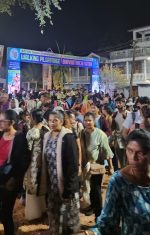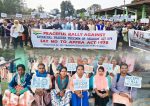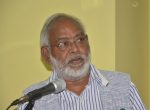By Matters India Reporter
Kachin: More than 100,000 people now live in camps for internally displaced persons (IDP) in Myanmar after an ethnic conflict reignited in Kachin state in 2011. Efforts at brokering peace have not resulted in a cessation of armed conflict until now, reports reliefweb.int.
Trócaire, the official overseas development agency of the Catholic Church in Ireland, and Oxfam have commissioned a new report that aims to bring together internally displaced women to share their experience of the conflict, as well as their hopes and priorities for peace in Kachin state.
Oxfam is an international confederation of charitable organizations focused on the alleviation of global poverty.
Women from 12 different camps in both government-controlled areas and Kachin Independence Organisation (KIO)-controlled/non-government controlled areas joined the sharing.
They spoke of loss of family members, children, husbands, homes, and of everything the women owned before the conflict disrupted their lives. Violence, particularly physical and sexual violence against women, is heavily present in their past and current lives.
In most families, during the period of being displaced from their villages, women bore the major responsibility for taking care of family members, and often said they had been overwhelmed by the situation.
Most women had either directly experienced physical violence, sexual violence or forced labor, or witnessed the instances of the same against a close relative, extended family member, neighbor, or villager. The women also said there was “no justice” for women victims of violence.
Many stories of the women center on the loss of their land, property and various belongings. Many women reported giving birth while they were hiding in the jungle without any medical support or midwifery services, as well as the illness and death of their children.
The report also assesses the exclusion women experience from receiving relevant information related to conflict and peace — and hence, their exclusion from negotiation and decision-making processes. The testimonies also explore women’s deep desire for involvement in peace building.
Trócaire and Oxfam commissioned the research as part of the Durable Peace Programme funded by the European Union.
The Kachin Independence Movement began during the British colonial rule in Myanmar (then known as Burma) in the 1940s. It wanted to address questions of ethnic group and minority representation and rights in the predominantly Bamar country of Burma.
Kachin troops previously formed a significant part of the Burmese army. With the unilateral abrogation of the Union of Burma constitution by the Ne Win regime in 1962, Kachin forces withdrew and formed the Kachin Independence Army (KIA) under the Kachin Independence Organization (KIO).
Aside from the major towns and railway corridor, Kachin state has been virtually independent from the mid-1960s through 1994, with an economy based on smuggling, jade trade with China, and narcotics.
A Myanmar army offensive in 1994 seized the jade mines from the KIO and the Kachin Independence Army signed a peace agreement with the Myanmar Government on February 24, 1994.
Fighting erupted between Kachin Independence Army and Myanmar Army troops on June 9, 2011, when government forces allegedly broke the ceasefire and attacked KIA positions. Fighting occurred throughout Kachin state, which is about the size of Portugal, as well as the northwestern portion of Shan State.
The violence has also resulted in the deaths of thousands of people. Both sides allege widespread use of landmines, child soldiers, and systematic rape and torture.
Numerous rounds of ceasefire talks have taken place between the Kachin Independence Army and the Myanmar government since 2011.
In 2013 the NGO Kachin Women’s Association Thailand reported that the fighting had created more than 100,000 refugees and that 364 villages had been wholly or partially abandoned since 2011.
The report also stated that the Myanmar Army deliberately attacked refugee camps and villages as well as committed alleged “war crimes” such as the rape and murder of civilians.
Child soldiers have and continue to play a major part in the Myanmar Army as well as rebel movements. In September 2012 the Myanmar Armed Forces released 42 child soldiers and the International Labour Organization met with representatives of the government as well as the Kachin Independence Army to secure the release of more child soldiers.










